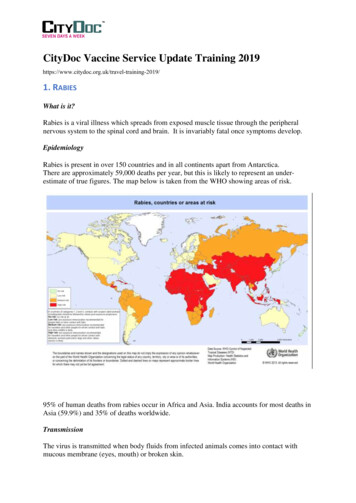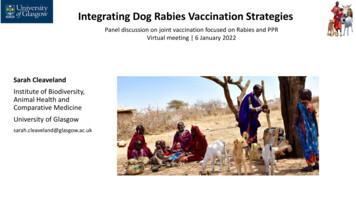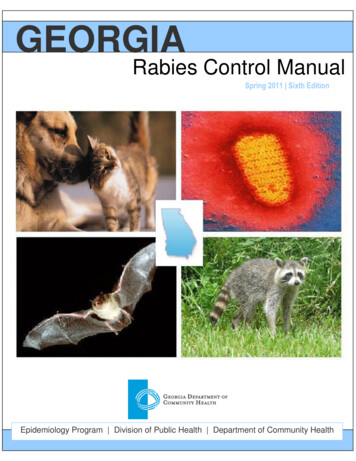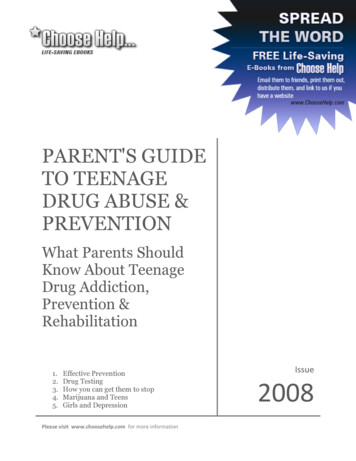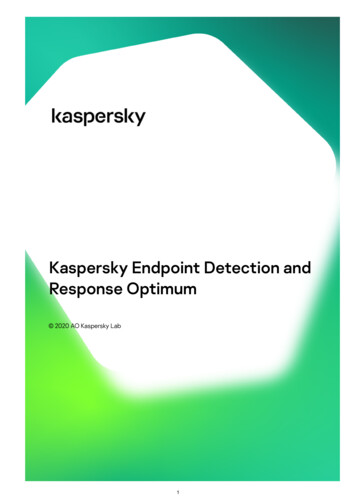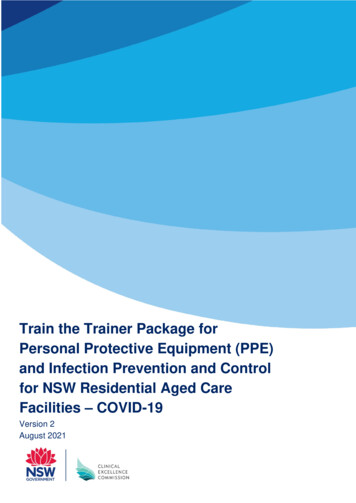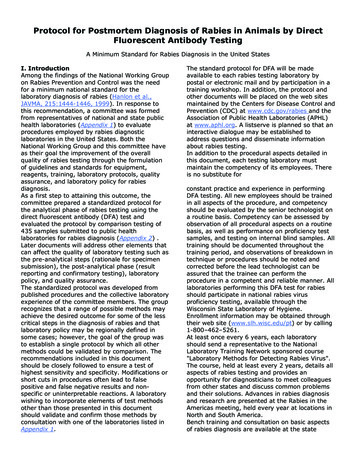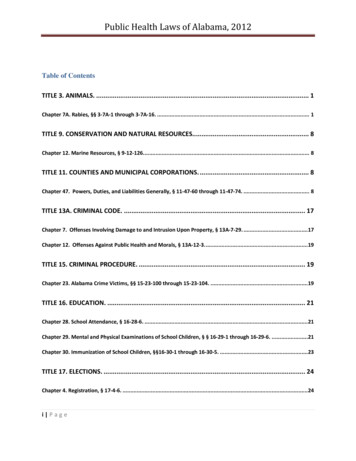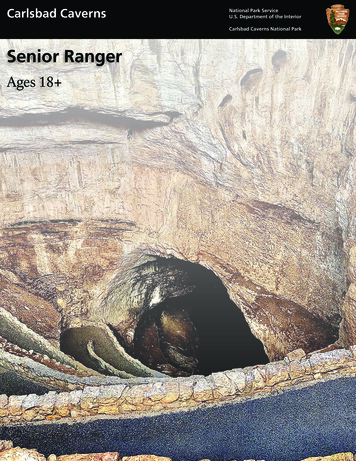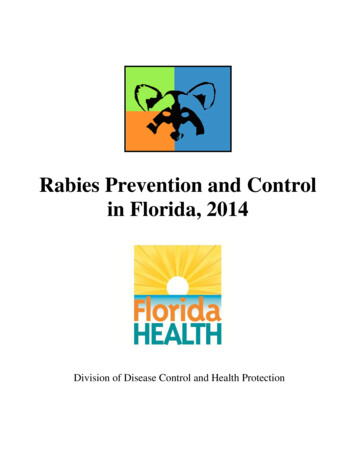
Transcription
Rabies Prevention and Controlin Florida, 2014Division of Disease Control and Health Protection
FLORIDA DEPARTMENT OF HEALTHDivision of Disease Control and Health ProtectionExecutive SummaryThe purpose of this compendium is to provide recommended policies and procedures for rabiesprevention and control in Florida. It is intended primarily for use by county health department staff,animal control specialists, veterinarians, health care providers and others with related responsibilitiesor interests. This publication, while produced and distributed by the Florida Department of Health,Division of Disease Control and Health Protection, has been developed by a multidisciplinary FloridaRabies Advisory Committee that represents the major agencies, institutions and organizations involvedwith rabies prevention and control in the state.Much of the information presented has been derived from materials previously published by thedepartment as an operational manual (Rabies and Animal Bite Investigation, HRSM 150-10, 1987), aninformational monograph (Rabies in Florida, Burridge, Sawyer and Bigler, 1986) and various policystatements issued over the past decade. Rabies Prevention and Control in Florida, 2008 is referencedas procedural guidelines in 64D-3 of the Florida Administrative Code. Procedural guidelinesrecommended in this document follow national standards published in the annual Compendium ofAnimal Rabies Control by the National Association of State Public Health Veterinarians. All materialincluded on the management of human exposure and treatment of rabies is consistent withrecommendations published in “Use of a Reduced (4-Dose) Vaccine Schedule for PostexposureProphylaxis to Prevent Human Rabies Recommendations of the Advisory Committee on ImmunizationPractices” (MMWR 2010;59(RR-2):1-9, "Human Rabies Prevention - United States, 2008Recommendations of the Advisory Committee on Immunization Practices" (MMWR Early Release2008;57:1-28), and Control of Communicable Diseases Manual (Heymann, APHA, 2008,19th edition).Specific areas addressed are coordination between relevant organizations, agencies and institutions;clinical descriptions of disease symptoms in animals and humans; protocols for proper handling,packing and shipping and testing of animals for rabies examination; confinement and management ofbiting animals; disposition of animals exposed to rabies; investigation of animal bites to people; humanpre-exposure immunization and post-exposure prophylaxis; access to human rabies vaccine; andguidelines for epidemic control measures.ii
Florida Rabies Advisory Committee MembersFlorida Department of Health (DOH)Carina Blackmore, MS Vet Med, PhD, State Public Health VeterinarianValerie Mock, Virologist, Bureau of Public Health Laboratories (BPHL)-JacksonvilleBrandon Brantley, PharmD, Chief, Bureau of Public Health PharmacyThomas Belcuore, MSM, Bureau of Preparedness and ResponsePaul Myers, Director, Alachua County Health DepartmentDanielle Stanek, DVM, Medical Epidemiologist, Bureau of Epidemiology*David Wingfield, Microbiologist, BPHL-Tampa*Patti Jones, Microbiologist, BPHL-Pensacola*Elesi Quaye, Microbiologist, BPHL-Miami(850) 245-4732(904) 791-1539(850) 922-9036(352) 334-7902(352) 334-8892(850) 245-4117(813) 974-3497(850) 595-1883(305) 324-2432Florida Department of Agriculture and Consumer Services (FDACS)William Jeter, DVM, Chief, Bureau of Animal Disease ControlJohn E. Crews, DVM, MS, Diagnostic Veterinarian Manager, District 4Mike Short, DVM, Equine Program Manager, Bureau of Animal Disease Control*Sam Lamb, DVM, Import and Export, Bureau of Animal Disease Control(850) 410-0942(863) 519-8663(850) 410-0901(850) 410-0900Florida Animal Control Association (FACA)Paul Studivant, Director, St. Johns County Division of Animal Control(904) 209-0655Florida Fish and Wildlife Conservation Commission (FWC)Investigator Linda Harrison, Division of Law Enforcement Captive WildlifeMark Cunningham, DVM, Wildlife Veterinarian(850) 488-6253(352) 334-4233Florida Department of Environmental Protection (DEP)Dana C. Bryan, MS, Environmental Policy Coordinator, Florida State Parks(850) 245-3104Florida Veterinary Medical Association (FVMA)Larry Helm, DVM, Veterinarian, Quincy Animal Hospital(850) 875-4811Florida Medical Association (FMA)Mahesh Setty, MD, Emergency Medicine, North Florida Regional Medical Center(352) 333-4000Humane Society of the United States (HSUS)Laura Bevan, Eastern Regional Director(850) 386-3435University of Florida (UF)Paul Nicoletti, DVM, MS, Professor, College of Veterinary Medicine*Samantha Wisely, Wildlife Ecologist, UF Dept Wildlife Ecology and Conservation*John Lednicky, PhD, UF Dept of Environmental and Global Health(352) 392-2239(352) 846-0643(352) 273-9204Nova Southeastern UniversityJohn Pellosie, Jr. DO, MPH, NSU COM, Chair, Preventative Medicine(954) 262-1459USDA-APHIS Wildlife Services*Betsy Haley, Wildlife Biologist(863) 519-5525iii
Please address comments or corrections to: Dr. Carina Blackmore, Chair, Rabies Advisory Committee, 4052Bald Cypress Way, Bin #A12 Tallahassee, FL 32399 or email: carina.blackmore@flhealth.gov.*Florida Rabies Advisory Committee Liaisons and Affiliatesiv
TABLE OF CONTENTSFlorida Rabies Advisory Committee Position Statements.viii Translocation of Raccoons and Other Wild Mammals (January 2007) Multi-year Rabies Vaccinations for Dogs and Cats (January 2008) Managing Feral/Free-Roaming/Un-owned/Stray cats (January 2007) Exhibition, Sale or Trade of Exotic or Wild Indigenous Mammals (June 2010)1 – LEGAL AUTHORITY AND RESPONSIBILITIES.1A. Legislative Authority .11. Chapter 381, Florida Statutes2. Chapter 64D-3, Florida Administrative Code3. Chapter 474, Florida Statutes4. Chapter 828, Florida Statutes5. Chapter 585, Florida Statutes6. Chapter 379, Florida Statutes, and Chapter 68A, Florida Administrative Code7. County OrdinancesB. Florida Department of Health Responsibilities 21. County Health Departments2. Bureau of Epidemiology3. Bureau of Public Health Laboratories4. Bureau of Public Health PharmacyC. Responsibilities of Other Agencies and Contributions by Allied Providers .41. Florida Animal Control Agencies and Florida Animal Control Association2. Florida Fish and Wildlife Conservation Commission3. Florida Department of Agriculture and Consumer Services4. Florida Department of Environmental Protection5. Florida Veterinary Medical Association, Florida Medical Association, and FloridaOsteopathic Medical Association6. State and Local Law Enforcement7. Centers for Disease Control and Prevention8. United States Department of Agriculture-Animal and Plant Health Inspection Service9. United States Department of Interior10. Humane Society Organizations11. Kansas State University Rabies Laboratory12. University of Florida13. World Health Organization/Pan American Health Organization2 - RABIES BACKGROUND AND GENERAL VIRUS INFORMATION.9A. Background-US.9B. Background-Florida.10C. Virus characteristics.11D. Florida Rabies Virus Variants. .12E. Clinical Signs (Animal). .131. Dogs2. Cats3. Raccoonsv
4. Bats5. Foxes and Coyotes6. Ferrets, Skunks and Otters7. Horses and Mules8. Rodents and Rabbits9. Monkeys and Other Non-Human Primates3 - EXPOSURE AND RISK ASSESSMENT.18A. Definitions of Rabies Exposures.181. Bite Exposure2. Non-bite ExposuresB. Risk Assessment and Investigation.191. Animal Behavior, Health and Characteristics2. Animal Vaccination Status3. Type of Encounter4. Status or Disposition of the AnimalC. Key Risk Assessment Questions.214 – HUMAN RABIES PROPHYLAXIS.22A. Primary or Pre-Exposure Immunization and Serologic Testing.221. Human Rabies Vaccine2. Serologic Examination/Booster Doses of Vaccine3. Serologic Testing Using the Rapid Fluorescent Focus Inhibition TestB. Post-Exposure Prophylaxis .231. Local Wound Treatment2. Treatment of Previously Immunized Humans3. Treatment of People Not Previously ImmunizedC. Rabies Post-Exposure Prophylaxis Costs/Patient Assistance Programs.26D. Diagnosis of Clinical Rabies in Humans.265 - RABIES: ANIMAL MANAGEMENT .30A. Animal Pre-Exposure Vaccination.301. Vaccines2. Serologic Confirmation of Antibody Titer for International ExportB. Types of Confinement.311. Isolation and Observation Periods – Suspect Rabid Animal Exposes a Person2. Animal Quarantine -- Animal Exposes Another Animal3. Rabies Alert/Area QuarantineC. Confidentiality.37D. Animal Post-Exposure Prophylaxis (PEP) .37E. Laboratory Testing, Billing and Sample Submittal Policies and Procedures .381. General Public Health Testing and Billing Policy2. Policies related to FDACS Animal Disease Diagnostic Laboratories3. Sample Collection and Testing Procedure4. Instructions for Preparing, Packing, and Shipping Specimens for Rabies Examination5. Reporting .vi
6 - EPIDEMIC CONTROL MEASURES.44A. Coalition Development and Public Awareness. .44B. Enforcement of State Rabies Laws and Local Ordinances. .44C. Rabies Alert and Area Quarantine.45D. Rabies Vaccination Campaign for Dogs and Cats During an Area Quarantine .47E. Oral Rabies Vaccine. . .48APPENDIX. .501. List of Acronyms, Abbreviations, and Definitions. . 512. Rabies Contacts. .543. Florida Rabies-Related Statutes and Administrative Codes. .564. Draft 64D-3, F.A.C. Extract Rabies Prevention and Control in Florida. .665. Management of Human Patients with Possible Rabies Exposure .696. Decision Tree for Healthcare Providers .717. Rabies Post-Exposure Prophylaxis (PEP) Administration Guidance and Schedule forHealthcare Providers and Patient Handout . .728. Confidential Rabies Post Exposure Prophylaxis (PEP) Report Form. .759. Model County Health Department Rabies PEP Refusal Letter (English/Spanish).7810. Rabies and Wildlife Pets .8211. What You Should Know About Rabies (Rabies FAQs). .8312. Model Memorandum of Agreement for Rabies Control Activities (for County HealthDepartments and Animal Control Agencies). . .8413. USDA-Approved Animal Rabies Vaccines. .8614. NASPHV Rabies Vaccination Certificate. .8915. Owner Request Form for Wildlife or Hybrid Wildlife Vaccination . . .9016. Model Letter to Victim, to Animal Owner, and Rabies Program Home ConfinementAgreement Form (English/Spanish/Creole). .9117. FWC Construction Requirements for Wild Canids (wolves, coyotes). .10018. FWC License to Possess Wildlife for Personal Use. . .10119. FWC Class III Personal Use Application and Questionnaire .10220. Management of Animal Patients Exposed to Known or Potentially Rabid Animals;Public Health Guidelines for Florida Veterinarians.10621. Agreement for Confinement at a Veterinary Facility. . .10822. DOH Bureau of Public Health Laboratories Rabies Test Form and Contacts .10923. Rabies Bureau of Public Health Laboratories Submission Regions. . .11124. Animal Bite Report Form. . .11225. Rabies Awareness Template Press Release. . 11526. Rabies Alert Template Press Release. . .11627. Issues to be Addressed in Government-Sponsored Oral Rabies Vaccine Proposal. . .11728. Template Raccoon Relocation Letter . .11929. Oral Rabies Vaccination Bait Handout issued June 2007 USDA WS. . .12030. Questions and Answers: Rabies and Oral Rabies Vaccination USDA WS. . .121vii
Rabies Advisory Committee Position StatementsTranslocation of Raccoons and Other Wild Mammals (updated January 2007)The translocation of raccoons from Florida to Virginia in the early 1970s is considered a major factorresponsible for the expanding epidemic of animal rabies in the eastern part of the country. Within thestate, the translocation of nuisance raccoons accounts for epizootics in counties previously unburdenedby animal rabies problems.The Florida Rabies Advisory Committee supports the Florida Fish and Wildlife ConservationCommission rule (68A-24.005, Florida Administrative Code) that prohibits the transport of wildtrapped, live raccoons within, into, or from Florida unless authorized by FWC permit due to the highprevalence of rabies in this species. The Rabies Advisory Committee strongly discourages thetranslocation of other rabies vector species.Further, translocation of any wild animal species raises the possibility of the spread of other zoonoticdiseases (e.g. plague) and should be discouraged.Multi-year Rabies Vaccinations for Dogs and Cats (updated January 2008)The Rabies Advisory Committee adopts the recommendation of the National Association of PublicHealth Veterinarians’ Compendium of Animal Rabies Control, 2008 in regard to 3-year rabiesvaccines for dogs and cats:"Vaccines used in state and local rabies control programs should have at least a 3-year duration ofimmunity. This constitutes the most effective method of increasing the proportion of immunized dogsand cats in any population.”Additionally, the Rabies Advisory Committee considers animals vaccinated by a licensed veterinarianusing a United States Department of Agriculture-approved multi-year vaccine to be currentlyvaccinated in accordance with the schedule for which the vaccine is licensed. Local governmentscannot mandate revaccination of currently vaccinated animals except in instances involving postexposure booster for rabies (Florida Statutes 828.30).Managing Feral/Free-roaming/Un-owned/Stray Cats (updated January 2007)The concept of managing free-roaming/feral domestic cats (Felis catus) is not tenable on public healthgrounds because of the persistent threat posed to communities from injury and disease. While the riskfor disease transmission from cats to people is generally low when these animals are maintainedindoors and routinely cared for, free-roaming cats pose a continuous concern to communities.Children are among the highest risk for disease transmission from these cats.While free-roaming cats can be vaccinated against rabies, this does not address the ongoing need toprovide them health care, medications and prevention of other zoonotic diseases. Should one of thesecats bite or scratch a person, it would need to be captured and observed for 10 days for signs andsymptoms of rabies, even if it had been previously vaccinated. If the cat is not found, the person bittenviii
would need to undergo rabies post-exposure treatment (average cost 3,000 for previouslyunvaccinated individual).In the past 10 years, cats were reported with rabies more frequently than dogs in Florida. Theoverwhelming majority of these cats were free-roaming animals. Human rabies in Florida was largelycontrolled by the removal of stray dogs when dog rabies was common during the first half of the1900s.Ideally, cats should have regular veterinary care and be maintained inside people's homes. Allowingcats to roam free is not in the best interests of the community’s health and deliberate release orabandonment of feral or domestic cats is not sanctioned under Florida’s conservation and cruelty laws.Domestic cats are not “indigenous” or native to Florida, and relocating and releasing non-nativespecies into the wild is a violation of Florida Statute 379.231 and Florida Administrative Code 68A4.005. Due to their adverse impact on wildlife, the Florida Fish and Wildlife Conservation Commissiondoes not issue permits to make lawful either the release of cats to the wild or the establishment offeral/free-roaming cat colonies.Exhibition, Sale, or Trade of Exotic or Wild Indigenous Mammals (updated June 2010)The Rabies Advisory Committee condemns the practice of using most wild or exotic mammals forpublic contact activities (i.e., picture taking with Class II Wildlife).Captive bred rabies vector species (e.g., raccoons, skunks, bats, foxes or bobcats) are being offered forexhibition, sale, or trade at a variety of venues (flea markets, pet fairs, exotic animal shows, swapmeets, etc.). All persons in possession of these animals must be appropriately permitted by FloridaFish and Wildlife Conservation Commission (Florida Statute 379.3761) and the Rabies AdvisoryCommittee recommends that both vendors and purchasers be pre-immunized against rabies.Due to the high potential for bites or scratches and difficulty of follow-up investigations, the RabiesAdvisory Committee recommends that county government monitor all events of this type. Florida Fishand Wildlife Conservation Commission law enforcement officers can seize illegally possessed wildlifeincluding wild caught rabies vectors (Florida Administrative Code 68A-6.002).ix
CHAPTER 1LEGAL AUTHORITY AND RESPONSIBILITIESA. Legislative Authority (Appendix 3)1. Chapter 381, Florida Statutes (F.S.), “Public Health”: authorizes the DOH to “. administer andenforce laws and rules relating to sanitation, control of communicable diseases, illness and hazardsto health among humans and from animals to humans, and the general health of the people of thestate.” Records maintained as a result of rabies exposure investigations are confidential and madepublic only when necessary to public health (381.0011 (2), F.S.).2. Chapter 64D-3, Florida Administrative Code (F.A.C.), “Procedures for Control of SpecificCommunicable Diseases”: details general DOH policies and procedures related to rabies controlincluding, but not limited to the following: 1) requiring that animal bites to humans by a potentiallyrabid animal be reportable to the county health officer, 2) establishing authority for quarantine,outlining quarantine requirements and specifying conditions for the transportation and removal ofquarantined persons and animals, and 3) outlining procedures for preventing rabies in humans,managing animals involved in bite incidents and declaring area-wide quarantines (64D-3.0293.033, 3.036, 3.038-3.041).3. Chapter 474.203(5) (a), F.S., “Veterinary Medical Practice”: states that “. only a veterinarian mayimmunize or treat an animal for diseases which are communicable to humans and which are ofpublic health significance.”4. Chapter 828.30, F.S., “Cruelty to Animals”: requires that all dogs, cats and ferrets shall bevaccinated by a licensed veterinarian against rabies with a United States Department of Agriculture(USDA) - approved vaccine. The cost of the vaccine shall be borne by the animal’s owner.Thereafter, the interval between vaccinations shall conform to the vaccine manufacturer’sdirections.” It also provides for exemptions, defines requirements for veterinarians to reportessential information to animal control agencies and defines penalties for violation of the law.5. Chapter 585, F.S., “Animal Industry”: requires that the Florida Department of Agriculture andConsumer Services (FDACS), Division of Animal Industry is authorized to.establish, maintain,and enforce quarantine areas within the state, or the entire state.to protect animals in the state.6. Chapter 379, F.S., “Wildlife” and Chapter 68A, F.A.C., “Florida Wildlife”: outlines the basicauthority of the Florida Fish and Wildlife Conservation Commission and responsibility relative towildlife.7. Most counties and some municipalities conduct rabies control programs under the auspices ofanimal control ordinances that may have more strict requirements than state statutes.1
B. Florida Department of Health ResponsibilitiesThe effectiveness of the rabies control program is dependent upon the coordinated efforts of severalofficial agencies in collaboration with allied organizations, institutions and associations. Specificresponsibilities of the Florida Department of Health (DOH) represent official policies and procedures.Those presented for other agencies and allied providers only represent suggested activities that mightappropriately augment any collaborative community rabies control initiative.1. County Health Departments (CHDs)Contact: local county health departments http://www.floridahealth.gov/Statutorily (Chapter 381, F.S. and Chapter 64D-3, F.A.C.), the CHD Director/Administrator hasprimary responsibility for the management of human exposures to rabid or suspect rabid animals andcontrol of animal rabies including quarantine. CHDs may elect to engage in memoranda of agreementwith other agencies to transfer certain responsibilities and activities. Collaborating agencies mayinclude animal control, the Fish and Wildlife Conservation Commission (FWC), sheriff’s offices, thelocal veterinary community, the Department of Environmental Protection (DEP) and other CHDs. Investigate human and pet rabies exposure incidents. Assure that health care providers of exposedpersons are informed about appropriate treatment recommendations, in consultation with the DOHDivision of Disease Control and Health Protection when necessary. Maintain proper records asrequired. Conduct an epidemiological investigation in every instance where a laboratory report indicates apositive case of rabies to elicit all possible persons or animals exposed. Ensure that local rabies control ordinances are established and updated as appropriate. Ensure, working with private health care providers, that rabies vaccine and human rabiesimmunoglobulin (HRIG) is available in the community within 24 hours of the rabies exposurediagnosis. Collect and maintain confidentiality of animal bite reports and related investigation notes. Report all cases in which a person receives or is recommended to receive post-exposureprophylaxis (PEP) via Merlin to the Bureau of Epidemiology. Report all monkey bites that could result in Herpes B virus infection via Merlin to the DOH Bureauof Epidemiology. Segregate, quarantine, and destroy domestic and wild animals having or suspected of having rabies. Facilitate human rabies PEP vaccinations for those in need. Arrange for specimen collection and expedited transportation of specimens to the DOH Bureau ofPublic Health Laboratories for analysis. Continually assess rabies trends, and when appropriate, declare a community “Alert” or“Quarantine,” and conduct a public information campaign. Inform the Bureau of Epidemiology (DCBE) of cases involving quarantine or testing ofunvaccinated livestock in a timely manner.2
In cooperation with other parties as necessary, assure that confined animals are kept in isolation insafe, sanitary, and humane conditions. As appropriate, facilitate pre-exposure vaccination of those at high risk of rabies exposure In some counties, the CHD Director/Administrator has delegated responsibility for carrying outcertain portions of this responsibility (such as collection of animal bite reports, investigation of biteincidents, and confinement of biting dogs and cats) to local animal control or other appropriateagencies through the development of local ordinances and intergovernmental agreements2. Bureau of Epidemiology (DCBE)Contact: (850) 245-4401 Develop appropriate regulations and procedures and update standards for statewide humanrabies prevention and control activities. Provide technical assistance (such as advice regarding rabies post-exposure prophylaxis, animalquarantine, risk assessment, and animal testing) to CHDs. Coordinate animal exposure investigations as appropriate with FWC and the FDACS; informFDACS Animal Industry of cases involving quarantine or testing of unvaccinated livestock in atimely manner. Approve rabies quarantines. Assist in coordination of interstate activities for the follow-up of animal bite and suspected rabiescases. Collect and collate data to monitor and evaluate program's effectiveness in preventing humanrabies and cost of inappropriate post-exposure treatment. Conduct statewide rabies surveillance. Submit reports to the Centers for Disease Control and Prevention (CDC) on the number of animalrabies cases identified statewide and provide periodic rabies reports and information to CHDs. Issue press releases and maintain internet websites with information related to rabies, rabiesquarantine, location of outbreaks, and rabies incidents of public interest. Serve as the liaison for: 1) other state agencies for the implementation of cooperative programs; 2)other states for the exchange of information and follow-up of animal bite incidents and rabies; and3) other countries [especially those in the Caribbean, Central and South America, through the PanAmerican Health Organization and the World Health Organization (WHO)], for the exchange ofinformation and follow-up of animal bite incidents and rabies. Inform FDACS of cases involving domestic animals in a timely manner. Convene annual meeting of the Florida Rabies Advisory Committee (RAC) to update statecompendium.3
3. Bureau of Public Health Laboratories (BPHL)Contact: see Appendix 22 for more informationThe BPHL, with locations in Jacksonville, Miami, Pensacola, and Tampa are the sole source of rabiesdiagnostic testing in Florida. Testing for surveillance purposes is available through other DOHapproved sources. Examine brain specimens by use of the Direct Fluorescent Antibody (DFA) technique (the CDCstandard rabies diagnostic technique). Conduct monoclonal antibody (MAB) testing on samplesfrom positive terrestrial mammals that are not analyzed using molecular typing to identify rabiesvariants in the state. Enter results into Merlin within one working day. Provide hard copy reports to agencies not usingMerlin by mail or fax within one working day. Report to submitting agency immediately by telephone any animal that tests positive for rabies orunsatisfactory for testing. Report to DCBE on a monthly basis, the total number and species of all specimens examined(positive and negative).4.Bureau of Public Health Pharmacy (BPHP)Contact: (850) 922-9036; after-hours for County Health Departments: 850-445-9446 In the event of an unanticipated local or industry shortage, BPHP will order, stock, and shiphuman vaccine and human rabies immune globulin (HRIG) to CHDs on request within oneworking day of the request. Monitor emergency stockpile for inventory control and dati
pre-exposure immunization and post-exposure prophylaxis; access to human rabies vaccine; and guidelines for epidemic control measures. iii Florida Rabies Advisory Committee Members . Confidential Rabies Post Exposure Prophylaxis (PEP) Report Form.75 9. Model County Health .
